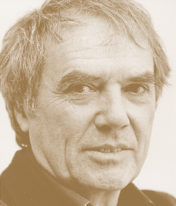Laudatio
The Praemium Erasmianum Foundation has established its topic for the 2006 Erasmus Prize as ‘Design for the public domain’. The generality of this topic was an explicit choice. It extends to a vast area of society, that of opinion- and decision-making and the organisation of our collective interests. This implies that we do not mean design as an aid to promote consumer articles. We mean the design for communication by governments and the state, corporate identities and signage systems for museums, institutions for the poor, nature parks, and theatre companies. In short, the public domain. This is the domain of shared values, from the street and town architecture to the virtual domain of the internet; from postage stamps to signposting of railway-stations and airports.
We tend to take it for granted that our society is guided by images, by photos of important events, by advertisements and strong visual stimulants that steer our activities and our perception of the world. It is hard to imagine a world without images. Visual communication has become more powerful than oral or textual communication and in recent decades has developed into a discipline of its own. This is a field of enquiry, where analysis of the communication process reaches far beyond the simple understanding of technical processes, or the aesthetic evaluation of pictures. Visual communication is a field of study made up of various branches of social science and humanities research. It is the domain of the graphic designers par excellence. We cannot deny that the quality of their work has an impact on the quality of our daily lives. Sometimes it seems that the better the quality of the design, the less we are aware of its influence. Few of us will pause to admire the design of an income-tax form when we open the blue envelope, and we all take it for granted that we have small handy maps for finding our way through the labyrinth of the underground in Paris or London.
Intellectual activity and reflection are required for visual communication in the public domain. The public domain designer is a thinker who is conscious of the other disciplines and forms of interaction with which he is involved during the design process. He must also take into consideration the significance of the final result for the user.
The work of this year’s laureate, Pierre Bernard, concentrates almost exclusively on the public domain, and on all sectors of the public domain. Starting with an outright activist approach during the Grapus years, Bernard has retained his social commitment, be it in different form, until the present day. He resents the ideological influence of advertising on graphic design and abides by this orientation in spite of general tendencies to commercialization and privatisation in the 80s and 90s of the last century. Basic to the view of Bernard and his colleagues in Grapus has been the opposition to the thinking prevalent in the 70s that culture was for the elite and corrupted politics, a view he has put into practice until the present day.
It is insufficient to discuss Bernard’s work in terms of originality and aesthetic appearance alone. The quality of his work rests on careful analysis of the assignment, its history and social context, and the feel for the perception by the user. His work is not just a well-considered product commissioned by an institution. As Bernard himself explains: to move the viewer, an image has to go through the filter of one’s personal experience and inner convictions, and you must make the message your own.
Bernard’s designs are a natural mixture of formal and informal elements and distinguish themselves by a playful declination of traditional symbols and lack of formal inhibitions. Bernard solves complex assignments not by a rigorous systematic. His solutions show a flexible combination of constant and variable form elements that provide space for subjectivity, humour and surprise within a set, objective graphic framework. Splendid examples of this approach are the signage systems for the Parc de la Villette in Paris, and the French national parks.
Inspired by graphic traditions in Poland, Germany, Switzerland and Holland, Bernard’s work in its turn has influenced graphic designers worldwide. As a teacher and organiser of events on the graphic arts, Bernard deserves our praise as much as for his artistic achievements. He is aware of the graphic designer’s shared responsibility in the quality of design in the public domain. His designs do not address the users as passive consumers, but stimulate participation. Bernard’s designs offer not just something to look at, but something to think about.
Monsieur Bernard, you have always emphasized that your achievements cannot be attributed to you alone. You have worked in groups of different composition, such as Grapus and the Atelier de Création Graphique. It is through these forms of collaboration that your work has developed, and I should like to acknowledge that here explicitly. By awarding the Erasmus Prize to you, we also honour your comrades-in-arms in the world of graphic design for their contribution to design in the public domain. I wish to congratulate you most warmly with the Erasmus Prize.
